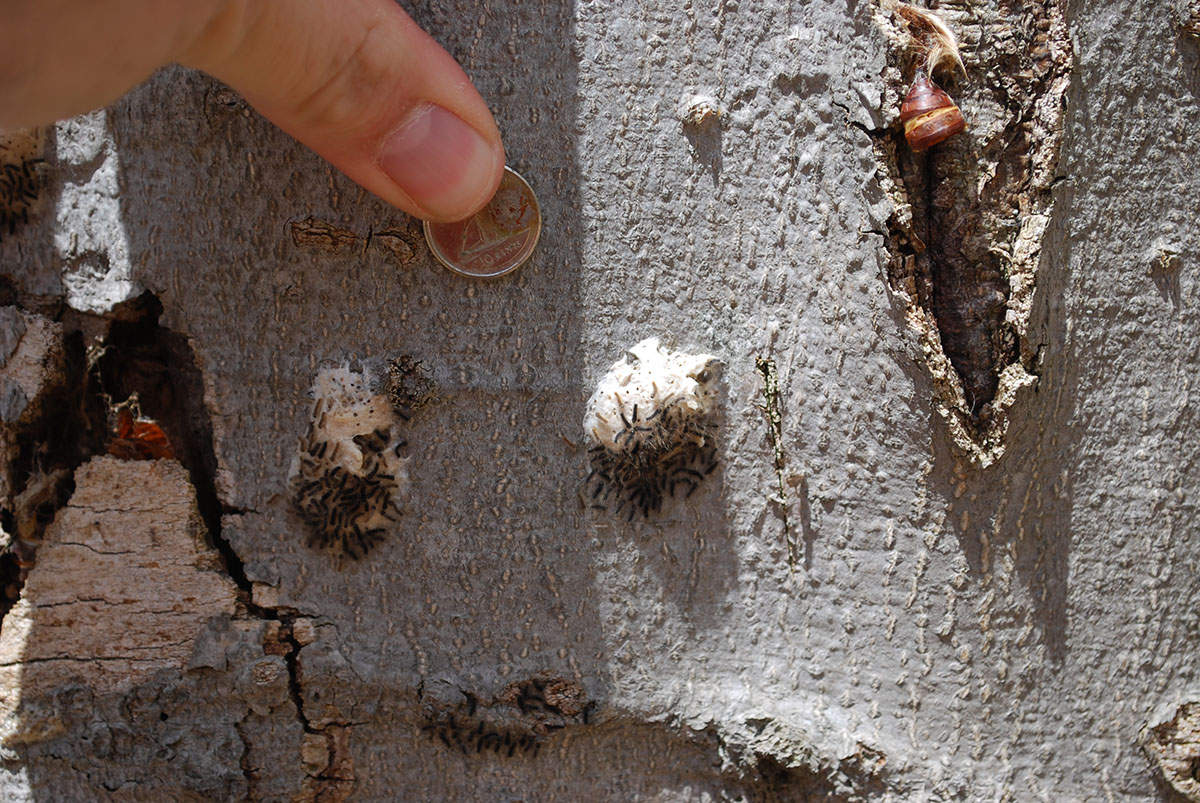The Town of Newmarket does not treat/manage trees on private property, however there are some steps residents can take to protect their trees from LDDs. Due to the favourable climate for the LDD moth, the developmental stages for LDD moths have been accelerated by a month. As the LDD moth is currently in the pupae/cocoon stage, residents can remove their burlap traps and any kind of trap from their trees and keep them for use next season.
Mid July (current year) to April (following year)
Scrape and destroy egg masses. You can do this by scraping egg masses off trees and placing them in a bucket of soap water for a day or two. Please wear gloves while doing this work as the caterpillars can irritate your skin.
How to Identify LDD Egg Masses
Egg masses are a small cluster of eggs that range in the size of a dime to a little bit bigger than a quarter. Egg masses can contain anywhere from 100 to 1,000 eggs. They are tan or light brown in colour and has a soft fuzzy look to it. These egg masses are typically found on the trunk of the tree anywhere from ground level up to about 60 cm above the ground is typical however they can be anywhere along the trunk. They are also commonly found on the undersides of branches, and in crevasses on the tree. Although less commonly found, the moths will also ley the eggs on the leaves, and on other nearby objects such as firewood, outdoor furniture, fences, and even the sides of sheds and houses.
Tools you need to remove LDD Egg Masses
- A tool for scraping such as a putty knife, butter knife, pot scraper or spoon
- Gloves and protective eye wear as LDD egg masses can cause skin irritation
- A container to hold the egg masses
- Dish soap and water
 How to remove LDD Egg Masses
How to remove LDD Egg Masses
1. Using your tool, scrape the egg masses into a container. When scraping the tree make sure not to damage the bark of the tree. Make sure to catch all of the eggs because ones that fall on the ground and aren't collected can still hatch next year.
2. To destroy the eggs, fill the container that you have collected the egg masses in with water and a bit of dish soap and let them sit in it for at least 48 hours then dispose of them.
Watch this video to learn more about how to remove LDD egg masses from trees.
Video: Learn how to scrape LDD egg masses from trees
April to June
Consider applying insecticide such as BTK or Tree Azin – both insecticides are not harmful to people or the environment. Many products have a tight window in order for the application to be successful. We recommend you contact a licensed tree care company to learn about your options to manage LDD.
May to early July
Use burlap bands to trap LDD caterpillars. Wrap a 45cm piece of the burlap entirely around the tree's trunk at chest height to catch the caterpillars. Tie a piece of string half-way up the burlap and fold the top section down over the string to create a skirt. This trap should be checked daily and any captured caterpillars should be removed and placed in a container of soapy water for a day or two before being disposed of. Please wear gloves while doing this work as the caterpillars can irritate your skin.
Video: How to install burlap bands on trees
June to July
During this time, you can handpick the caterpillars/pupae/cocoon and place them in a bucket of soapy water for a day or two. Please wear gloves while doing this work as the caterpillars/pupae/cocoon can irritate your skin.